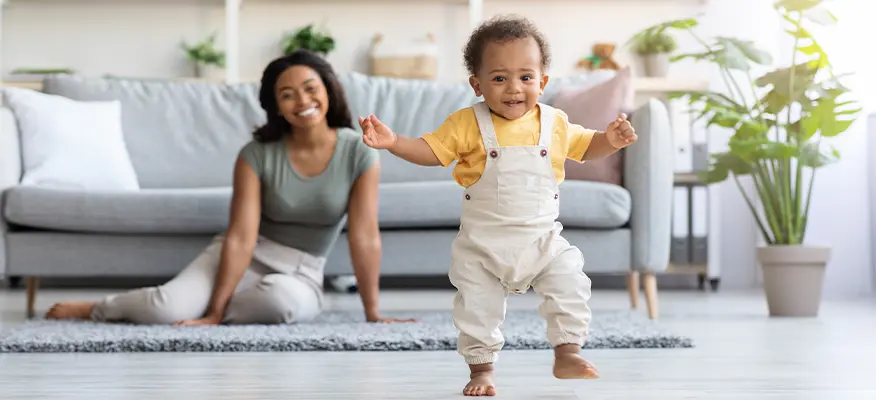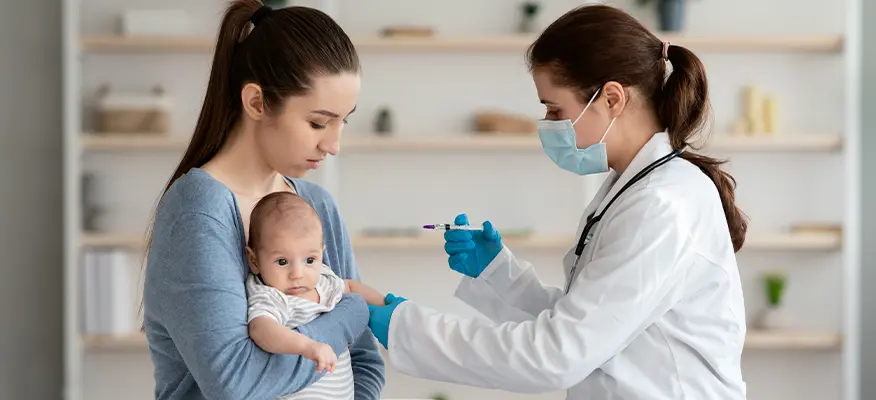Ways To Help Your Baby Learn To Walk

Key Highlights
- Physical activity in babies brings about physical and mental development in the baby.
- Running, jumping, walking, crawling, etc., can be performed as activities based on the growth and the ability of the baby.
- Tummy time and sit-ups for babies are major core-strengthening exercises.
- Bicycle motion relieves gas and is important for the leg movements of the baby.
- Belly rubs, burping, etc., help in relieving pain due to gas.
Parents of newborns are committed to creating an optimal environment for their baby’s growth, prioritizing their baby’s physical health and emotional well-being. They aspire for their baby to develop rapidly, acquiring knowledge and understanding at a swift pace.
There are some ways to help your baby learn to walk that parents should be mindful about. They want the baby to walk, talk and be active as early as possible, and to do that, physical activity plays a very important role in not only the physical development but also, the mental development of the baby. How to help your baby learn to walk is a big task as far as parenting is concerned. There are several ways to help a baby learn to walk. Read on to know more.
How to help your baby learn to walk is a big task as far as parenting is concerned. There are several ways to help a baby learn to walk. Read on to know more.
Benefits of physical activity for kids
Babies are born with weak muscles and bones. In their early years, it is very important that you help them promote their muscular development. According to pediatricians, parents need to help babies build flexibility, coordination, and strength with some age-appropriate routines and activities. This will help them walk sooner and with more confidence.
Engaging in regular exercise offers numerous benefits beyond weight management and disease prevention for children. Improved motor skills in children often correlate with higher levels of physical activity. It is crucial for babies and toddlers to be physically active on a daily basis as it promotes healthy growth and development.
Healthy muscles and bones are an indicator of overall health. If the baby has good muscular strength and healthy bones, chances are they will also learn to crawl, walk, and run about faster.
You must be wondering about the tips to get your baby or toddler walking or how to teach your baby to walk. The next section has more.
Exercises for newborns and infants (0-12 months)
Babies should be encouraged to be active throughout the day, every day in a variety of ways, including crawling.
If they’re not yet crawling, encourage them to be physically active by reaching and grasping, pulling and pushing, and moving their head, body, and limbs during daily routines, and during supervised floor play.
Try to include at least 30 minutes of tummy time spread throughout the day when they’re awake. Once babies can move around, encourage them to be as active as possible in a safe and supervised play environment.
Exercises for toddlers (12–36 months)
Toddlers should be physically active every day for at least 180 minutes (three hours). The more the better. This should be spread throughout the day, including playing outdoors.
The 180 minutes can include light activities such as standing up, moving around, rolling, and playing, as well as a more energetic activity like skipping, hopping, running, and jumping.
Active play, such as using a climbing frame, playing in the water, chasing games, and ball games, is the best way for this age group to get moving.
Core-strengthening exercises for babies
Give your baby tummy time
Age: 0 months onwards
This is the most common of all trunk-strengthening exercises for babies suggested by pediatricians. Simply put your newborn on his tummy after every feeding. This act builds the core muscles of your baby’s tummy. There are many variations to this, such as:
- Place your baby on a blanket so he can also get some floor-time and explore his surroundings.
- Place your baby on your tummy between your knees. This also helps the baby to release trapped gas.
- Place your baby on daddy’s tummy! This is a fun and very useful variation of tummy time that can be done after you’ve breastfed the baby, or in the evening time before bed. This also strengthens the emotional bond between the father and baby.
Tip: Remember that whenever your child is not lying on the back, he is working on increasing his head control and neck strength.
So, minimize their lying down time after your child is two to three months old and make sure that your baby is getting exposure to enough physical activity.
Help your baby sit up
Age: 4 months (or when a baby is able to support her head)
Place a blanket on the bed and then place the baby on it. Then, hold the blanket on each side slightly above the head, with your baby in the middle of your arms. Slowly lift the blanket so your baby comes to a sitting position, then lower it back down again. This is a very simple and safe exercise to help your baby gain upper body strength.
Teach this exercise to your baby:
- This little core exercise really helps babies as they start crawling, standing, and walking.
- Lay your baby down and let him pull himself up and put him back down.
- Let your baby lead this exercise as it strengthens his core.
- After doing this exercise, a baby gets better at sitting up.
- Daily exercise also helps babies sleep better and stay happier all day!
Other Exercises
1. Bicycle Motion
Age: 0 months onwards
Your little one’s leg development is also a key area of concern, especially as the leg muscles help determine how soon he/she will be able to crawl and walk. Pediatricians recommend the following baby leg strengthening exercise to develop your baby’s leg muscles:
Position the baby on their back and delicately grip their ankles. Gradually move their legs in a circular motion, imitating the action of pedaling a bicycle. Repeat this movement four to five times consecutively. Afterward, allow the baby a short pause of a few minutes before continuing.
Did you know? Bicycle legs is among the best ways to relieve your baby’s gas! Pediatricians say that when your baby is practicing bicycle legs, the movement helps release bubbles from his stomach and move them through the intestines. This way, your baby can pass these bubbles naturally and not face any gas pain.
When to do this? Check if your baby’s stomach feels hard and bloated. He may be gassy, and this exercise will soothe him.
If your baby resists and does not want to have you pedal his legs, don’t force him.
2. Do Some Dancing!
Age: 0 months onwards
Babies like to be moved around and held up on their toes. As per doctors, this toe and foot motion is excellent for their leg muscle development.
Simply hold your baby gently under his armpits and touch his toes on the ground. Since you are now supporting most of his weight, let him balance gently. Notice that your baby will often kick, which will make it look like he is dancing.
Note: Be sure to give your baby extra support as he finds it very difficult to stand up now. It is not recommended to practice this exercise for a prolonged duration as the little one will get tired.
3. Help Your Baby Pick Up/Lift Objects
Age: 4–6 months
Doctors suggest that picking up objects is a good way to build your baby’s grasping ability and hand–eye coordination, as well as muscular strength.
Make your baby sit in a high chair or bouncy seat. Now place some toys or household items in front of your baby. Encourage them to lift one, examine it, put it down, and then lift it (or another object) again. You may have to show them how to do this a few times, but most babies learn very quickly and enjoy this exercise a lot!
Exercises for Gas problems in Babies
If your baby is having painful gas, here are five tricks that should help her feel better:
Move Those Little Legs
If your baby is lying on his back, gently move the legs back and forth to imitate riding a bicycle. This exercise helps with intestinal motion and can expel trapped gas. You can also bend his legs and gently push the knees up towards the tummy. If he’s on his tummy, you can help ease him into Child’s Pose (just like in yoga) and that motion will have the same effect.
A Gentle Tummy Rub
Baby massage is a technique employed by nurses to provide comfort to infants experiencing gas bubbles. Place your baby on their back and gently massage their tummy using circular motions. This circular motion stimulates abdominal activity, aiding in the release of trapped gas bubbles.
Baby Burping
Of course, the best go-to for any fussy baby is to burp them. Sometimes one good burp will do the trick. It may not happen right away, so burp him, lie him down for a few minutes, then gently pick him up and try again. Keep giving tummy time a try.
Infant Massage
Infant massage is a way to gently nurture and spend time with your baby.
Massage is one age-old trick that never fails. The benefits of an oil massage are now well accepted by doctors, and it can definitely help make your baby’s muscles and bones stronger.
You can start massaging your baby’s body early—as early as a week or two old. There are a few movements/exercises that you should do as part of baby massage in order to build the baby’s strength:
- Hold your baby’s wrists and lift the baby off the massage table. This exercise helps the development of the cervical spine.
- Place your baby on the tummy, his knees spread apart but his feet together. Press the baby’s feet with your thumbs. Your baby will try to push himself forward. This exercise is very useful for leg muscle development.
- Place your baby on the tummy, his knees spread apart but his feet together. Press the baby’s feet with your thumbs. Your baby will try to push himself forward. This exercise is very useful for leg muscle development.
Note: Make sure you do NOT use rigorous or high-pressure strokes. Only a gentle massage using skin-friendly baby oil is beneficial for your baby’s improved blood circulation, and in turn, bodily strength.
Benefits of Infant Massage
Research suggests that infant massage can have various health benefits. For example, infant massage might:
- Encourage interaction between you and your baby
- Help your baby relax and sleep
- Positively affect infant hormones that control stress
- Reduce crying
Some studies also suggest that infant massage involving moderate pressure might promote growth for premature babies.
How do I massage my baby
Infant massage involves a little preparation and some basic techniques. To get started:
- Create a calm atmosphere: If possible, do the massage in a warm, quiet place—indoors or outdoors. Sit comfortably on the floor or a bed or stand in front of the changing table and position your baby on a blanket or towel in front of you. Place your baby on their back so that you can maintain eye contact.
- Control your touch: Use a gentle touch when you first start massaging your baby. Do not tickle the baby as it can lead to irritation. As your baby grows, use a firmer touch.
- Slowly stroke and knead each part of your baby’s body: You might start by placing your baby on his or her stomach and spending one minute each rubbing different areas, including your baby’s head, neck, shoulders, upper back, waist, thighs, feet, and hands. Next, place your baby on his or her back and spend one minute each extending and flexing your baby’s arms and legs, and then both legs at the same time. Finally, with your baby either on his or her back or stomach, repeat the rubbing motions for another five minutes.
- Stay relaxed: Talk to your baby throughout the massage. You might sing or tell a story. Try repeating your baby’s name and the word ‘relax’ as you help him or her release tension.
- Watch how your baby responds: If your baby jiggles his or her arms and seems happy, he or she is likely enjoying the massage and you can continue. If your baby turns his or her head away from you or appears restless or unhappy, stop the massage and try again later.
Should you use oil?
Some parents prefer to use oil during infant massage to prevent friction between their hands and the baby’s skin.
If you choose to use oil, select one that’s odorless and edible—just in case your baby gets some in his or her mouth.
If your baby has sensitive skin or allergies, test the oil first by applying a small amount to a patch of your baby’s skin and watching for a reaction.
It might take a few tries before you and your baby get the hang of infant massage. Be patient. With a little practice, an infant massage can be a healthy way for you and your baby to relax and bond.
Conclusion
To conclude, these are the different ways to help baby learn to walk and promote his physical and mental development.
Now that you are aware of how to help your baby learn to walk and how to make your baby walk, you can also include some core-strengthening exercises, bicycle movements, and exercises to be performed when the baby has gas problems.
Along with these exercises, the baby should also be massaged every day.



